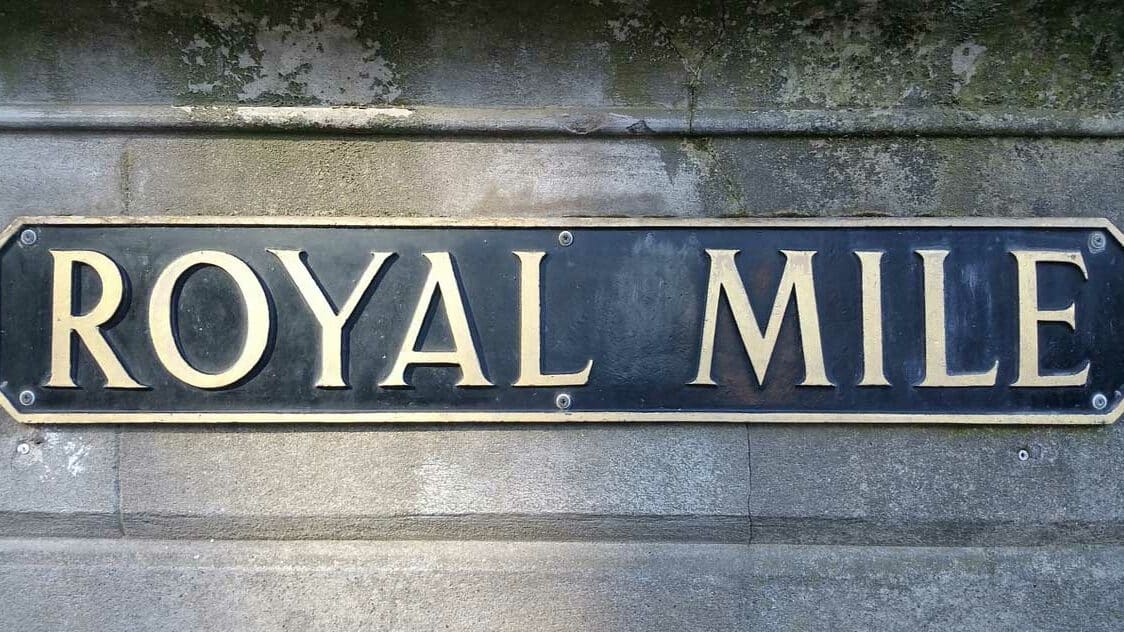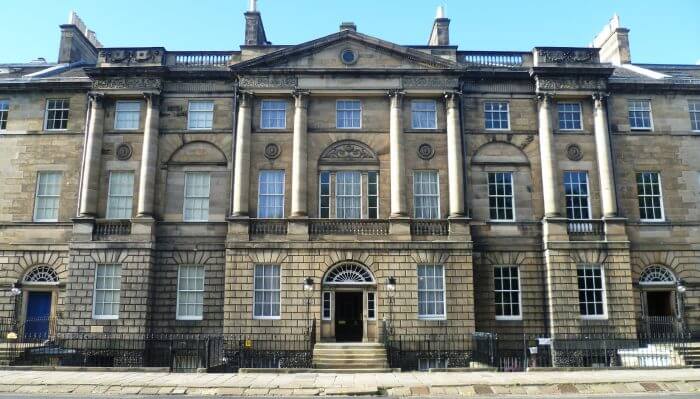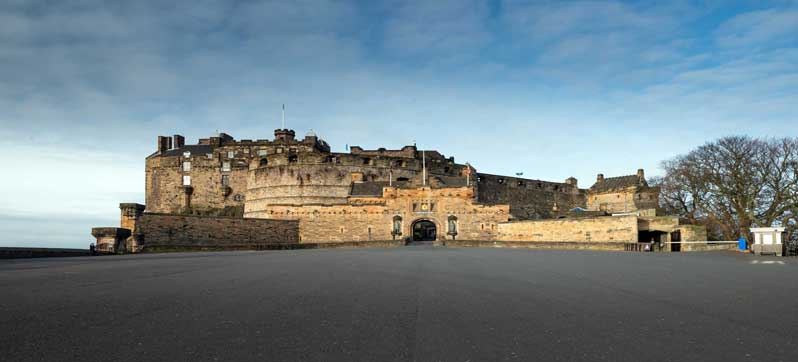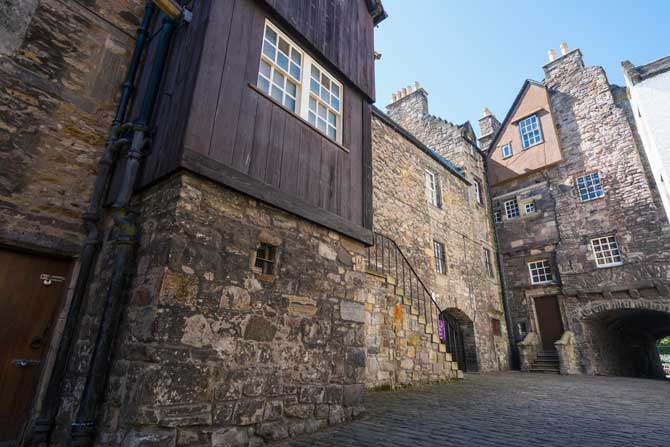
Edinburgh street names reveal much about the city’s history. Have you ever stopped to think about the origins?
These names originate from various sources, including notable politicians, royalty, forgotten battles, and well-known figures.
Understanding these origins provides a fascinating insight into Edinburgh’s past.
Many street name entries include links. These lead to more detailed articles on Truly Edinburgh or other reputable sources, offering further information.
Table of contents
Ready to explore? This guide looks at the fascinating origins behind Edinburgh’s street names. It categorises them to help you uncover the unique stories of Scotland’s capital city.
Origins of Edinburgh New Town streets

When the New Town was first built many of Edinburgh’s street names were carefully chosen to show loyalty to King George III and the Hanoverian dynasty.
1. Cumberland Street: This quiet New Town street was named after William Augustus, the Duke of Cumberland, the youngest son of King George II, who defeated Bonnie Prince Charlie at the battle of Culloden in 1746.
2. George Street: George Street is named after King George III. It was built in the late 18th century as part of the New Town development and became a fashionable commercial street.
3. Charlotte Square: Originally called St George Square This lovely New Town Square took its name from Queen Charlotte the wife of George III. Architect Robert Adam designed the houses that stood on the square.
4. Frederick Street: In James Craig’s original New Town street plan this street is listed as “Queen Street.” The name was altered in compliment to Frederick, Duke of York.
5. Hanover Street: Hanover Street is named after the House of Hanover, the ruling British royal house during the time of its construction in the late 18th century. The House of Hanover included King George III and subsequent monarchs.
6. Picardy Place: Named after the Protestants who sought refuge in Edinburgh from the French region of Picardy (Picardie) after the revocation of the Edict of Nantes in 1685,
7. Princes Street: Princes Street is one of the most famous streets in Edinburgh. It’s named after King George III’s sons, Prince George (later King George IV) and Prince William.Some sources suggest that Edinburgh authorities had initially planned to call it St Giles after the city’s patron saint.
8. The Mound: The Mound is an artificial hill located between the Old Town and the New Town. It was created in the late 18th century by dumping the excavated soil from the construction of the New Town. The name “Mound” simply refers to its mound-like shape.
9. George IV Bridge: George IV Bridge is a prominent street that spans the valley between the Old Town and the southern part of the city. It is named after King George IV, who visited Edinburgh in 1822.
10. Royal Circus: Royal Circus is a circular street located in the New Town area of Edinburgh. It was designed in the early 19th century by architect William Henry Playfair and is named for its circular shape reminiscent of a circus arena.
11. Rose Street: Designed as part of James Craig’s New Town plan in 1767, Rose Street was named after the national flower of England, an intentional unionist pairing with Thistle Street.
- This article from Edinburgh World Heritage says more about the history of Rose Street.
Thistle Street: also part of the original New Town plan was named after Scotland’s national emblem.
- This article from Edinburgh World Heritage says more about Thistle Street.
12. Waterloo Place: Taken from Duke Wellington’s victory at the Battle of Waterloo over Napoleon in 1815.
13. Waverley Bridge: Waverley Bridge is a street located near Waverley Station, Edinburgh’s main railway station. It is named after Sir Walter Scott’s novel Waverley, which was published in 1814 and became hugely popular.
Origins of Edinburgh Old Town streets

14. Royal Mile: The Royal Mile is a historic street that stretches from Edinburgh Castle to the Palace of Holyroodhouse. It is not officially named “Royal Mile,” but rather refers to the succession of streets: Castlehill, Lawnmarket, High Street, Canongate, and Abbey Strand. The name signifies the royal connection between the castle and the palace.
This feature article on Truly Edinburgh says more about the Royal Mile.
15. Abbey Strand: The smallest of the Royal Mile streets took its name from the nearby Holyrood Abbey.
16. Anchor Close: Situated on the Royal Mile’s High Street, the close previously known by other names took its name from the Anchor Tavern which was the meeting place of the rather boisterous Edinburgh men’s club which occasionally entertained Robert Burns
17. Canongate: Canongate is a historic street that forms part of the Royal Mile. The name “Canongate” refers to the street’s association with the canons (clergy) of Holyrood Abbey, which was located nearby.
- This feature article on Truly Edinburgh says more about Holyrood Abbey.
18. Candlemaker Row: Candlemaker Row is a street that runs parallel to the Royal Mile. It is named after the candlemakers who operated in the area during the 17th century.
19. Chambers Street: This short street takes its name from William Chambers, a prominent social reformer, writer and Lord Provost of Edinburgh.
- This feature article on Truly Edinburgh says more about William Chambers.
19. Cockburn Street: Cockburn Street is named after Lord Cockburn, a prominent Scottish lawyer and judge who lived during the 19th century. He was known for his efforts to preserve and improve the city’s architectural heritage.
20. Cowgate: The Cowgate, originally one of Edinburgh’s most fashionable areas was the route along which cows were driven from their grazing to the city markets.
21. Dundas Street: This Edinburgh New Town thoroughfare was named after the controversial Rt. Hon. Henry Dundas, first Viscount Melville, whose statue stands on top of a towering column. Inspired by Trajan’s column in Rome, the column and statue dominate St Andrews Square.
22. Grassmarket: The name Grassmarket comes from its historical use as a market for horses and cattle. The area was originally called “Grazing Market” due to the grassy pasture where animals including horses and cattle were brought for sale. For a time during the 17th and 18th centuries, the Grassmarket became a place of public execution.
- This feature article on Truly Edinburgh says more about the history of the Grassmarket.
23. High Street: High Street is one of the main streets on the Royal Mile. It was originally called the “High Gate” due to its position on the highest point of the Old Town. Over time, it became known as the High Street.
24. Hunter Square: From Sir James Hunter Blair, Lord Provost of Edinburgh in 1784 and Conservative member of Parliament 1780-1784.
25. Kings Stables Road: Built close to St Cuthbert’s Church and Edinburgh Castle, this ancient thoroughfare, probably built during the reign of James IV, was used as a ‘tilting yard ’for medieval jousting tournaments and as the site of the royal stables.
26. Mary King’s Close: Previously known as Touris Close and Brown’s Close and possibly named after the daughter of Mr Alexander King.
Today this Royal Mile tourist attraction allows visitors to explore underground streets closed as the plague swept through Edinburgh in 1645.
- This feature article on Truly Edinburgh says more about Mary Kings Close.
27. Niddry Street: Located close to the Royal Mile in the Old Town, Niddry Street, mentioned in a 1477 charter as ‘Nudreis Wynd’. The name was probably associated with Robert Niddry, an Edinburgh magistrate in 1437.
28. Spittal Street: Located near the Grassmarket, this street was named after Sir James Spittal a successful silk merchant and Lord Provost of Edinburgh 1833-1837.
29. Victoria Street: Victoria Street took its name from Queen Victoria, who reigned from 1837 to 1901. The street was built in the mid-19th century and is known for its vibrant and colourful buildings.
30. Wariston’s Close: This Royal Mile close had several of names over the years but originally took its name from Wariston’s land, the house of Sir Archibald Johnstoun (Johnstone) of Wariston (Warriston). Johnstoun was one of the authors of the National Covenant signed in Greyfriars’ Church in 1638.
- This feature article on Truly Edinburgh says more about Greyfriars Kirk.
31. West Port: This well-known Edinburgh street name was originally the gate furthest west in the Flodden wall, leading out of the Grassmarket.
Origins of other Edinburgh streets
32. Alan Breck Gardens: This Edinburgh street ( Clermiston takes its name from a character from Robert Louis Stevenson’s Kidnapped.
33. Craigmillar Castle Road: Quite simply take from the medieval Craigmillar Castle in Edinburgh, a favourite of Mary Queen of Scots.
This feature article on Truly Edinburgh says more about Craigmillar Castle.
34. Castle Avenue: This Corstorphine street took its name from the ancient Corstorphine Castle, built by Sir Adam Forrester between c. 1374 and 1405.
35. Roseburn Terrace: This residential street is located near the Murrayfield Stadium. The name could be derived from the ancient Roseburn house possibly c. 1560.
Others suggest that the name is connected to the rose bushes that once grew abundantly in the area, along with the word “burn,” which means a small stream or river in Scotland
36. Dalrymple Crescent: Located in today’s EH9 postcode the crescent took its name from Lady Anne Dalrymple, second daughter of the 9th Earl of Stair, part of a family that played a part in the ebb and flow of Scotland’s history.
37. Dunrobin Place: Set in Edinburgh’s leafy Stockbridge area, Dunrobin Place took its name From Dunrobin Castle the magnificent family home of the Dukes of Sutherland which overlooks the Dornoch Firth.
38. Easter Road: Early maps (c. 1830) show Easter Road, once used by Mary Queen of Scots as the eastern road from the city to Leith.
39. Jock’s Lodge: Once considered a village in South Leith Parish Edinburghshire. Perhaps taken from a beggar who built a hut there. The name ‘Jokis Lodge’ was first seen in 1650.
40. Livingstone Place: Located in the Meadows area, planners named it after explorer and missionary David Livingstone who was born many miles away in Blantyre, South Lanarkshire in 1813.
41. Merchiston Avenue: Less than 2 miles from the west end of Princes Street, this thoroughfare took its name from the 15th century Merchiston Castle (AKA Merchiston Tower), once the home of John Napier, the 8th Laird of Merchiston and the inventor of logarithms.
42. Restalrig Road: Restalrig Road between Meadowbank and Craigentinny took its name from the ancient village of Restalrig formerly Lestalrig from the family De Lestalrig who lived there between 1128 and 1382
References: research for the origins of Edinburgh Street names
Edinburgh World Heritage, Street Stories (Online) Accessed 27 May 2025.
Watson, Charles B. Boog. 1975. History and Derivation of Edinburgh Street Names. Edinburgh: Oliver & Boyd.
The book Wilson reference uses a range of primary sources including maps and early documents and histories. It is also available through SCRIBD which requires you to open an account and may be chargeable.
Note
For today’s rules around naming Edinburgh street names, the City of Edinburgh Council says, “In general, new streets are named after people, places or events associated with the City of Edinburgh to preserve history and sustain our sense of place…”
Related content on Truly Edinburgh

Discover Edinburgh old Town closes and wynds
Integral to the character of Edinburgh’s Old Town, especially along the Royal Mile, are its distinctive closes and wynds.
These narrow pathways and entrances historically served as vital access routes within the dense urban environment.